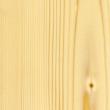Spruce, Whitewood
Picea abies
Green density
Average value
441 kg/m³
Total degree of shrinkage
axial
0,3 %
radial
3,6 %
tangential
7,8 %
Differential swelling
radial
0,19 %%
tangential
0,33 %%
Other characteristics
Thermal conductivity
0,11 W/mK
Equilibrium of moisture
content (20°/37%)
content (20°/37%)
7,0 %
Equilibrium of moisture
content (20°/83%)
content (20°/83%)
16,4 %
Hardness
Brinell hardness HB,0
32 N/mm²
Brinell hardness HB,90
12 N/mm²
Elastic properties
Flexural modulus of elasticity
12500 N/mm²
Strength properties
Flexural strength
77 N/mm²
Tensile strength
95 N/mm²
Compression strength
44 N/mm²
Natural durability
Fungi
4, less durable
Treatability
Heartwood
3, non-permeable
Sapwood
2, moderately permeable
Characteristic values determined from wood samples with a moisture content of 12%.
Its large distribution and high productivity in the right location makes the Spruce Tree (Picea abies) one of the most important kinds of trees, commercially, for Europe.
Its wood is moderately heavy, resilient and almost-white with a strong natural lustre.
Spruce trees are the source of valuable raw material for the paper and plasterboard industries, and are also used as construction timber to make furniture.
Its wood is moderately heavy, resilient and almost-white with a strong natural lustre.
Spruce trees are the source of valuable raw material for the paper and plasterboard industries, and are also used as construction timber to make furniture.



